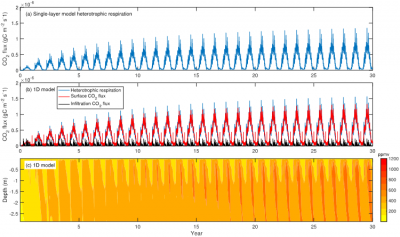BeTR-v2 for Robust Biogeochemical Modeling
Biogeochemical modeling is challenged with uncertainties from process representations, model parameters, initial and boundary conditions, and numerical implementations. Existing assessments of model structural uncertainty are often conflated with components other than biogeochemical representation, as is the case in the CMIP5 and CMIP6 experiments. To address this issue, we developed a vertically-resolved reactive transport solver (BeTR-v2) integrated in ELM to analyze diverse biogeochemical model representations in a robust numerical framework. We benchmarked the BeTR-v2 dynamic core with analytical solutions and found excellent agreement. We then explored how different numerical methods of coupling consumers, producers, and nutrients impact simulated carbon cycling. We found that coupling differences strongly affected simulated carbon and nutrient dynamics, and confirmed that calibration is not able to resolve these model differences. We conclude that robust numerical coupling is prerequisite to realize the full potential of any biogeochemical formulation, and the integration of BeTR-v2 in ELM is appropriate for this purpose.
BeTR-v2 enables a straightforward extension of single layer biogeochemical models into 1D vertically resolved models, and their further coupling with earth system land models, like ELM. By separating numerical methods from model process representations, BeTR-v2 is able to provide comprehensive assessment of structural uncertainty of biogeochemical models, making ELM unique among all earth system models.
Soil biogeochemistry is one of the most important yet most uncertain components in earth system models. However, existing earth system models are often structurally too rigid to incorporate diverse soil biogeochemical formulations, and thus fail to accurately quantify structural uncertainty and resulting implications to carbon-climate feedbacks. We here developed BeTR-v2 to fill this infrastructure gap in both ecosystem modeling capability and model benchmarking. BeTR-v2 enables the robust implementation of diverse soil biogeochemical models with different levels of complexities and underlying process hypotheses with the same set of rigorously-benchmarked numerical algorithms. Once implemented with BeTR-v2, a soil biogeochemical model will be able to run either in the standalone single-layer mode to mimic soil incubation experiments, or 1D soil column driven by measured soil edaphic conditions, or be coupled with ELM for site, regional, and global simulations. In one example, we implemented ELM-v1 soil biogeochemistry with BeTR-v2. By comparing with the default ELM-v1, we found that the BeTR-v2 enabled code predicted significantly different global carbon and nutrient dynamics. We further found that recalibrating the BeTR-v2 enabled code was not able to remove the difference with respect to the default ELM-v1. In particular, we found that due to the tighter coupling between nutrient mineralization and assimilation enabled by BeTR-v2, both nitrogen and phosphorus cycles become much tighter, i.e., ecosystems are better at retaining nutrients, such that nitrogen losses through hydrological leaching is 10% of that predicted by the default model. We conclude that BeTR-v2 integrated in ELM more robustly represent carbon and nutrient dynamics by minimizing uncertainty from numerical implementations.

